The Long-Term Surface Deformation Monitoring and Prediction of Hutubi Gas Storage Reservoir in Xinjiang Based on InSAR and the GWO-VMD-GRU Model
Abstract
1. Introduction
2. Study Area and Data Used
2.1. Background of the Study Area
2.2. Datasets
3. Methodology
3.1. SBAS-InSAR Method and Processing
3.2. Wavelet Denoising of Raw Time Series
3.3. GWO-VMD-GRU Model
4. Results
4.1. Deformation Rate
4.2. Accuracy Verification
4.3. Time Series Analysis
4.4. GWO-VMD-GRU Model Prediction Results
4.4.1. Trend Component Displacement Prediction
4.4.2. Periodic Component Displacement Prediction
4.4.3. Total Displacement Prediction
5. Discussion
5.1. Spatiotemporal Distribution Characteristics of Surface Deformation at the Underground Gas Storage Facility
5.2. Combined Effects of Gas Injection, Extraction, and Groundwater Extraction on Surface Deformation
5.3. Application of the GWO-VMD-GRU Model in Deformation Prediction
5.4. Model Limitations and Future Directions
5.5. Model Scalability and Potential Applications in Other Locations
5.6. Implications for Underground Gas Storage Operation and Management
6. Conclusions
- (1)
- Surface deformation at the storage facility is characterized by noticeable uplift in the central and northwestern regions, while subsidence occurs in the southeastern region. From the cumulative displacement of various gas wells, it is evident that deformation in the central area is relatively stable, while significant variations are observed in the northwestern and southeastern regions. Notably, the cumulative uplift at HUK14 and HUK12 exceeds 90 mm, which is substantially greater than the deformation at other wells. For these wells, it is recommended to adjust the gas injection and extraction pressure in the next phase, with appropriate pressure reduction or redistribution of injection volumes to wells with smaller deformation.
- (2)
- Surface deformation at the Hutubi UGS is primarily driven by the combined effects of gas injection and groundwater extraction. In particular, summer surface deformation in the northwestern, southeastern, and northern sides of the facility results from the interaction of natural gas injection and agricultural groundwater extraction. The cumulative deformation differences between the northwest and southeast gas wells can be attributed to the combined effects of these two driving forces. Wells such as HUK4 (uplift region) and HUK11 (subsidence region) exhibit significant gradient effects of groundwater extraction, with HUK11 showing the most noticeable deformation due to its proximity to agricultural irrigation wells. In contrast, the central area remains relatively stable because the agricultural wells are concentrated at the northern edge, and gas injection wells in this region are minimally affected by groundwater extraction. Overall, the combined influence of gas injection and groundwater extraction results in distinct spatiotemporal deformation patterns across the storage facility.
- (3)
- The GWO-VMD-GRU hybrid model proposed in this study integrates the strengths of the Gray Wolf Optimization (GWO) algorithm, Variational Mode Decomposition (VMD), and Gated Recurrent Unit (GRU) to accurately extract and predict trends and periodic components in deformation sequences. The R2 values for all three gas well monitoring points exceeded 0.98, and the model maintained stable prediction performance even in scenarios with complex deformation characteristics and large fluctuations. Compared to traditional models such as GRU and LSTM, the GWO-VMD-GRU model significantly outperforms in terms of prediction accuracy, particularly in modeling nonlinear and nonstationary geological time series data, confirming its adaptability and robustness.
Author Contributions
Funding
Data Availability Statement
Conflicts of Interest
References
- Hu, B.; Li, H.; Zhang, X.; Fang, L. Oil and Gas Mining Deformation Monitoring and Assessments of Disaster: Using Interferometric Synthetic Aperture Radar Technology. IEEE Geosci. Remote Sens. Mag. 2020, 8, 108–134. [Google Scholar] [CrossRef]
- Li, J.; Li, R.; Wang, X.; Shi, X.; Zheng, L.; Abudutayier·, Y.; Sun, X.; Chen, S.; Fang, W.; Cheng, R. Study on the Vertical Surface Deformation Mechanism of the Hutubi Underground Gas Storage in Some Areas. Chin. J. Seismol. 2016, 32, 407–416. [Google Scholar]
- Qiao, X.J.; Chen, W.; Wang, D.; Nie, Z.; Chen, Z.; Li, J.; Wang, X.; Li, Y.; Wang, T.; Feng, G. Crustal Deformation in the Hutubi Underground Gas Storage Site in China Observed by GPS and InSAR Measurements. Seismol. Res. Lett. 2018, 89, 1467–1477. [Google Scholar]
- Tang, L.; Lu, Z.; Zhang, M.; Sun, L.; Wen, L. Seismicity Induced by Simultaneous Abrupt Changes of Injection Rate and Well Pressure in Hutubi Gas Field. J. Geophys. Res. Solid Earth 2018, 123, 5929–5944. [Google Scholar] [CrossRef]
- Jiang, G.Y.; Qiao, X.J.; Wang, X.Q.; Lu, R.Q.; Liu, L.; Yang, H.F.; Su, Y.D.; Song, L.L.; Wang, B.S.; Wong, T.-F. GPS Observed Horizontal Ground Extension at the Hutubi (China) Underground Gas Storage Facility and Its Application to Geomechanical Modeling for Induced Seismicity. Earth Planet. Sci. Lett. 2019, 530, 115943. [Google Scholar] [CrossRef]
- Wang, Z.; Dou, K.; Yang, Y. Study on Surface Deformation Patterns and Mechanisms of the Hutubi Underground Gas Storage. J. Southwest Petro. Univ. (Nat. Sci. Ed.) 2022, 44, 79–90. [Google Scholar]
- Wang, Y.; Feng, G.; Li, Z.; Xu, W.; Zhu, J.; He, L.; Xiong, Z.; Qiao, X. Retrieving the Displacements of the Hutubi (China) Underground Gas Storage During 2003–2020 from Multi-Track InSAR. Remote Sens. Environ. 2022, 268, 112768. [Google Scholar] [CrossRef]
- Berardino, P.; Fornaro, G.; Lanari, R.; Sansosti, E. A New Algorithm for Surface Deformation Monitoring Based on Small Baseline Differential SAR Interferograms. IEEE Trans. Geosci. Remote Sens. 2002, 40, 2375–2383. [Google Scholar] [CrossRef]
- Bai, D.; Lu, G.; Hu, H.; Lin, H.; Chen, C.; Wang, X. Deformation Analysis and Reinforcement Effect Evaluation for the No. 65 Slope on the Shangsan Expressway Based on SBAS-InSAR. Buildings 2024, 14, 3582. [Google Scholar] [CrossRef]
- Zhang, P.; Guo, Z.; Guo, S.; Xia, J. Land Subsidence Monitoring Method in Regions of Variable Radar Reflection Characteristics by Integrating PS-InSAR and SBAS-InSAR Techniques. Remote Sens. 2022, 14, 3265. [Google Scholar] [CrossRef]
- Chen, K.; Wang, B. Monitoring and Predictive Analysis of Surface Deformation Using Combined SBAS-InSAR Technology and CS-Elman Neural Network: A Case Study of Wenchuan County, Sichuan Province, China. Photogramm. Eng. Remote Sens. 2025, 91, 53–63. [Google Scholar] [CrossRef]
- Dou, K. Study on Surface Deformation of the Hutubi Underground Gas Storage in Xinjiang Based on SBAS-InSAR. Master’s Thesis, Southwest Petroleum University, Chengdu, China, 2020. [Google Scholar]
- Wang, Y. Study and Application of Wide-Area InSAR Deformation Monitoring Method. Doctoral Dissertation, Central South University, Changsha, China, 2023. [Google Scholar]
- Wang, D.; Li, Y.; Nie, Z.; Wang, T.; Qiao, X.; Li, J.; Yu, P.; Cheng, R. GPS Study of Surface Cap Layer Deformation at the Hutubi Underground Gas Storage. Chin. J. Seismol. 2016, 32, 397–406. [Google Scholar]
- Zhang, Z.; Wei, B.; Shen, Z.; Wunier; Wang, T.; Wang, B.; Ruan, Y. Impact of the Hutubi Underground Natural Gas Storage on Surrounding Micro-Seismic Activity in 2016. Chin. J. Geophys. 2020, 63, 3387–3397. [Google Scholar]
- Zhao, R.; Yang, Z.; Zhou, W.; Guo, F. Cenozoic Tectonic Features and Earthquakes in the Piedmont Depression Zones on the Northern and Southern Flanks of the Tianshan Mountains. Seismol. Geol. 2000, 22, 295–304. [Google Scholar]
- Cao, X. Study on the Characteristics of In-situ Stress in an Underground Gas Storage Converted from a Depleted Gas Reservoir in Xinjiang. Doctoral Dissertation, China University of Geosciences (Beijing), Beijing, China, 2013. [Google Scholar]
- Zhang, P. Late Cenozoic Tectonic Deformation of the Tianshan Mountains and Its Foreland Basins. Sci. Bull. 2003, 48, 2499–2500. [Google Scholar]
- Pang, J.; Qian, G.; Wang, B.; Yang, Z.; Wei, Y.; Li, Y. Evaluation of Sealing Ability of the Underground Gas Storage Converted from the Xinjiang H Gas Field. Nat. Gas Ind. 2012, 32, 83–85. [Google Scholar]
- Yuan, M.; Li, M.; Liu, H.; Lv, P.; Li, B.; Zheng, W. Subsidence Monitoring Based on SBAS-InSAR and Slope Stability Analysis Method for Damage Analysis in Mountainous Mining Subsidence Regions. Remote Sens. 2021, 13, 3107. [Google Scholar] [CrossRef]
- Chen, R.; Li, J.; Liu, D. InSAR Study of Current Tectonic Deformation and Seismic Hazard Analysis of the Pargyirelazhang System in the Northeastern Pamirs. Geod. Bull. 2024, 8, 79–83, 89. [Google Scholar]
- Chen, R.; Li, J.; Liu, D.; Yushan, A.; Li, R.; Kong, X. InSAR coseismic deformation and seismogenic structure of the 2023 MW6.9 Tajikistan earthquake. J. Geod. Geodyn. 2024, 12, 1674–9847. [Google Scholar] [CrossRef]
- Cai, G.; Li, Y.; Liu, G. A Combined Wavelet-Wiener Filtering Algorithm and Its Application in InSAR Interferogram Denoising. J. Remote Sens. 2009, 13, 129–136. [Google Scholar]
- Ma, Z.; Yang, G.; Liu, T.; Wei, X.; Shi, S.; Chen, H. InSAR-based Subsidence Prediction Method Optimized by Wavelet-GRU-ARMA. Bull. Surv. Mapp. 2024, 12, 33–39. [Google Scholar]
- Qian, J.; Wu, A.; Ji, J.; Cheng, L.; Xu, W. Nonlinear Time Series Prediction in Geotechnical Engineering Based on a Wavelet-Optimized LSTM-ARMA Model. J. Tongji Univ. (Nat. Sci. Ed.) 2021, 49, 1107–1115. [Google Scholar]
- Dragomiretskiy, K.; Zosso, D. Variational Mode Decomposition. IEEE Trans. Signal Process. 2014, 62, 531–544. [Google Scholar] [CrossRef]
- Yang, F.; Zhi, M.; An, Y. Revealing Large-Scale Surface Subsidence in Jincheng City’s Mining Clusters Using MT-InSAR and VMD-SSA-LSTM Time Series Prediction Model. Sci. Rep. 2025, 15, 5726. [Google Scholar] [CrossRef] [PubMed]
- Wen, C.; Tian, H.; Zeng, X.; Xia, X.; Hu, X.; Pang, B. Landslide Deformation Analysis and Prediction with a VMD-SA-LSTM Combined Model. Water 2024, 16, 2945. [Google Scholar] [CrossRef]
- Jin, B.; Zeng, T.; Yang, T.; Gui, L.; Yin, K.; Guo, B.; Zhao, B.; Li, Q. The Prediction of Transmission Towers’ Foundation Ground Subsidence in the Salt Lake Area Based on Multi-Temporal Interferometric Synthetic Aperture Radar and Deep Learning. Remote Sens. 2023, 15, 4805. [Google Scholar] [CrossRef]
- Mirjalili, S.; Mirjalili, M.S.; Lewis, A. Grey Wolf Optimizer. Adv. Eng. Software 2014, 69, 46–61. [Google Scholar] [CrossRef]
- Li, J.; Li, B.; Peng, Y.; Tang, S.; Chen, Y.; Pei, W. Monitoring and Prediction of Ground Surface Settlement in Kunming Urban Area by Building GWO-LSTM Model Based on TS-InSAR. Appl. Sci. 2024, 14, 6036. [Google Scholar] [CrossRef]
- Cheng, R.; Li, S.; Han, Z.; Mao, J.; Li, Y. Surface Subsidence Prediction Based on the Combination of Time-Series InSAR and GWO-VMD. J. Guizhou Univ. (Nat. Sci. Ed.) 2023, 40, 78–85. [Google Scholar]
- Chao, Z.; Ying, C.; Lu, G.; Yue, W.; Motagh, M.; Roessner, S.; Hu, X.; Yin, K. A Novel Framework for Landslide Displacement Prediction Using MT-InSAR and Machine Learning Techniques. Eng. Geol. 2024, 334, 107497. [Google Scholar]
- Xiao, Y.; Tao, Q.; Hu, L.; Liu, R.; Li, X. A Deep Learning-Based Combination Method of Spatio-Temporal Prediction for Regional Mining Surface Subsidence. Sci. Rep. 2024, 14, 19139. [Google Scholar] [CrossRef] [PubMed]
- Jiang, Y.; Luo, H.; Xu, Q.; Lu, Z.; Liao, L.; Li, H.; Hao, L. A Graph Convolutional Incorporating GRU Network for Landslide Displacement Forecasting Based on Spatiotemporal Analysis of GNSS Observations. Remote Sens. 2022, 14, 1016. [Google Scholar] [CrossRef]
- Zhang, Y.; Tang, J.; He, Z.; Tan, J.; Li, C. A Novel Displacement Prediction Method Using Gated Recurrent Unit Model with Time Series Analysis in the Erdaohe Landslide. Nat. Hazards 2020, 105, 783–813. [Google Scholar] [CrossRef]
- Chen, W. InSAR Deformation Monitoring and Simulation Study of the Hutubi Underground Gas Storage in Xinjiang. Master’s Thesis, Institute of Seismology, China Earthquake Administration, Wuhan, China, 2016. [Google Scholar]
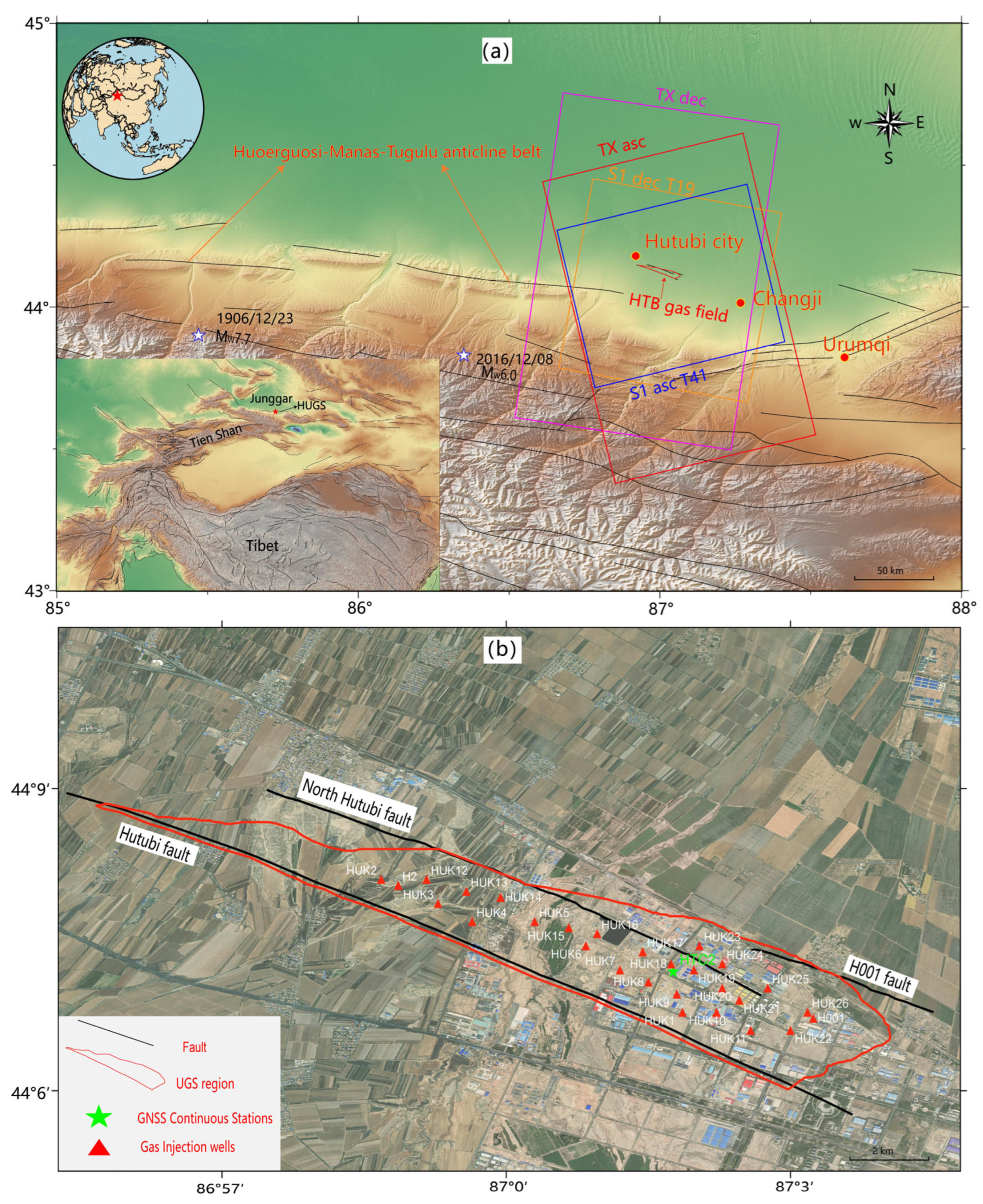
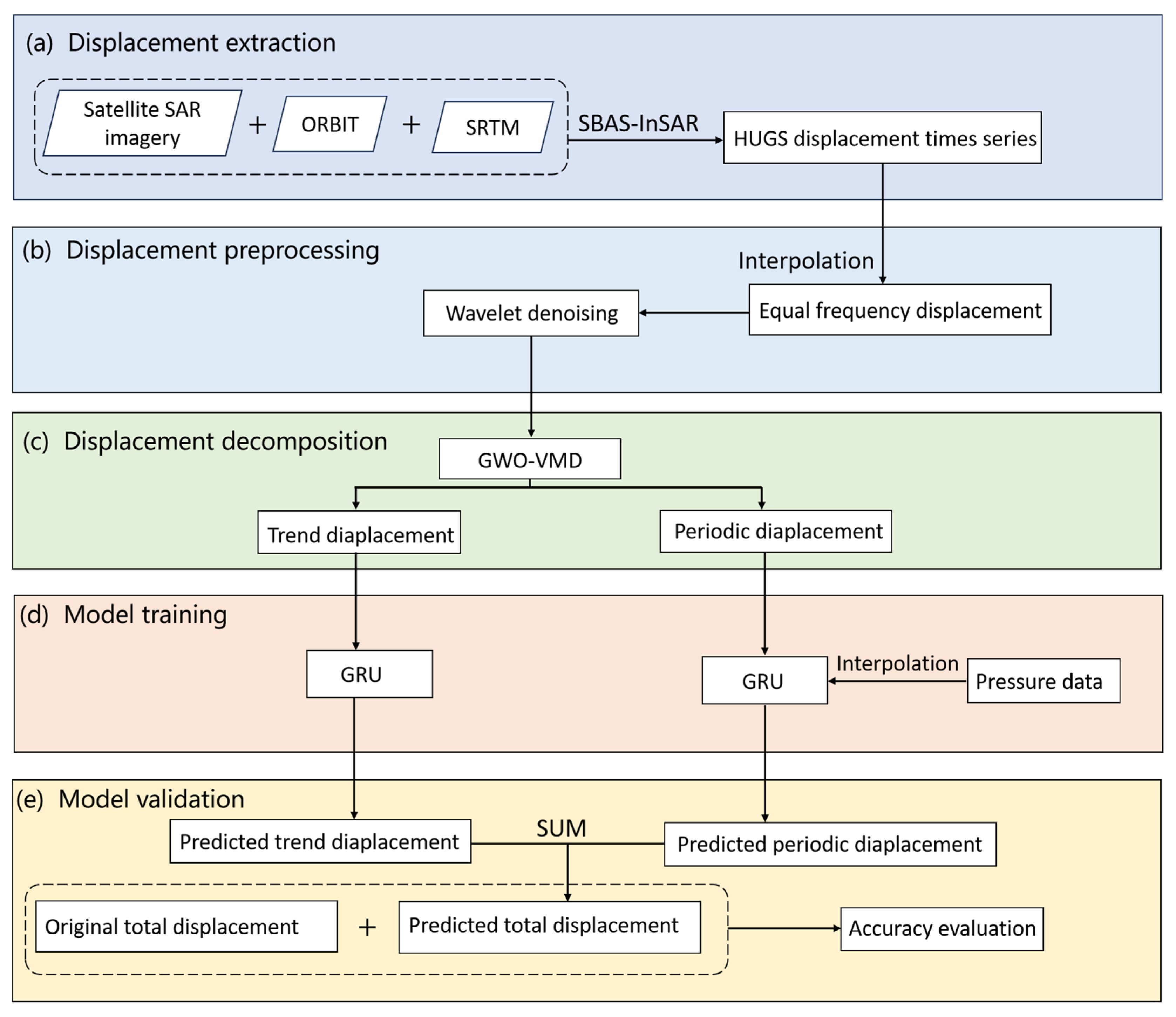


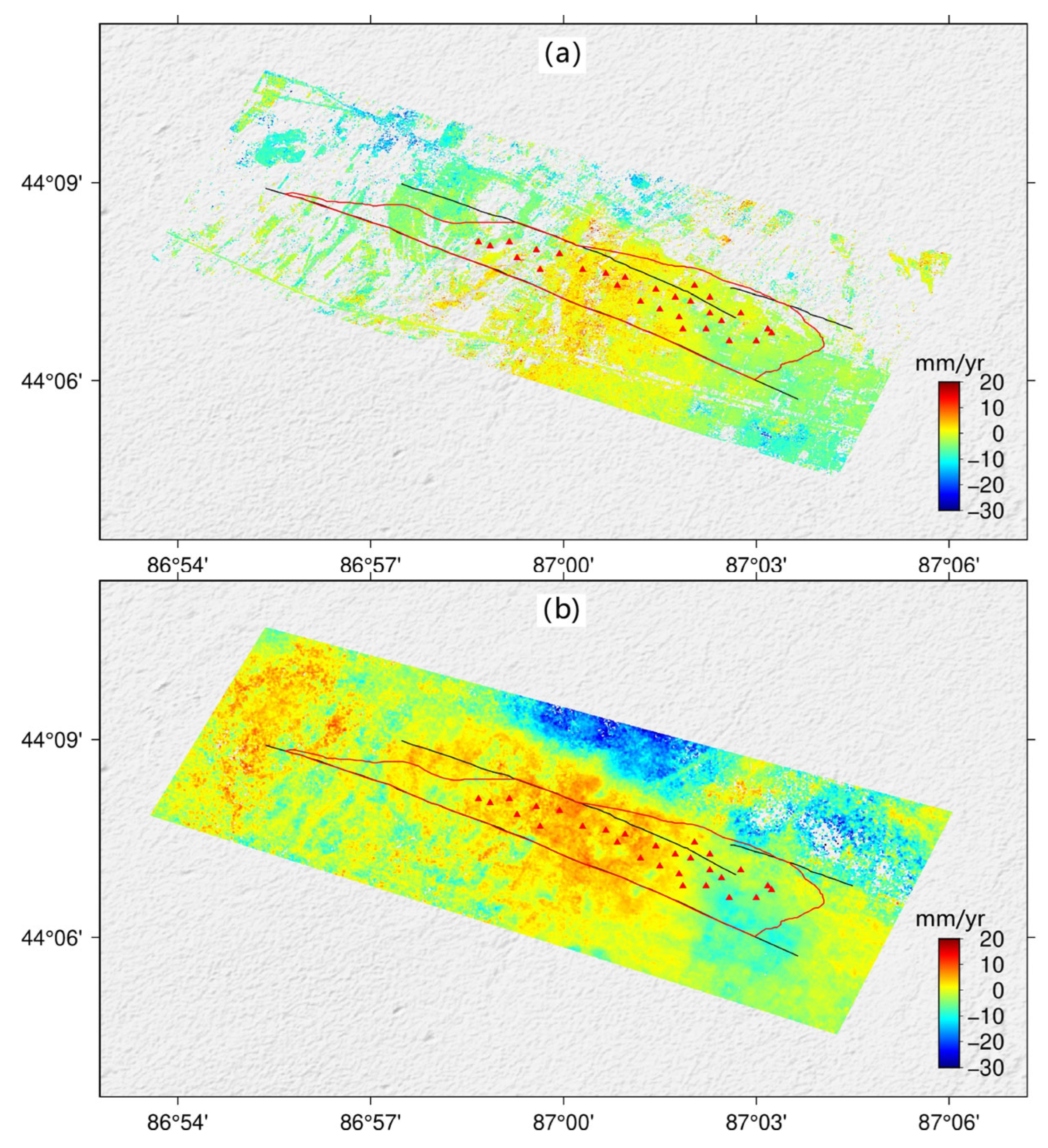
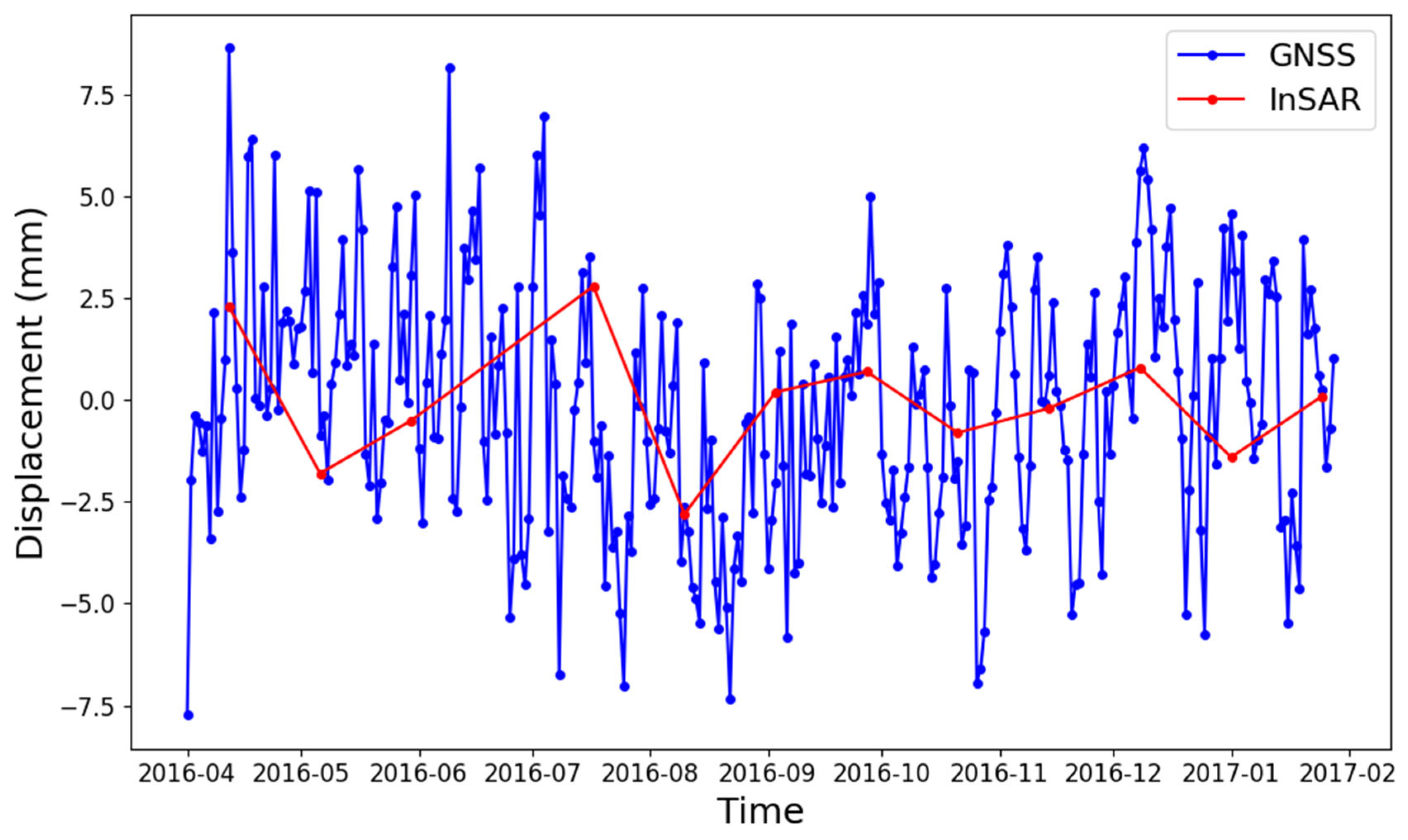
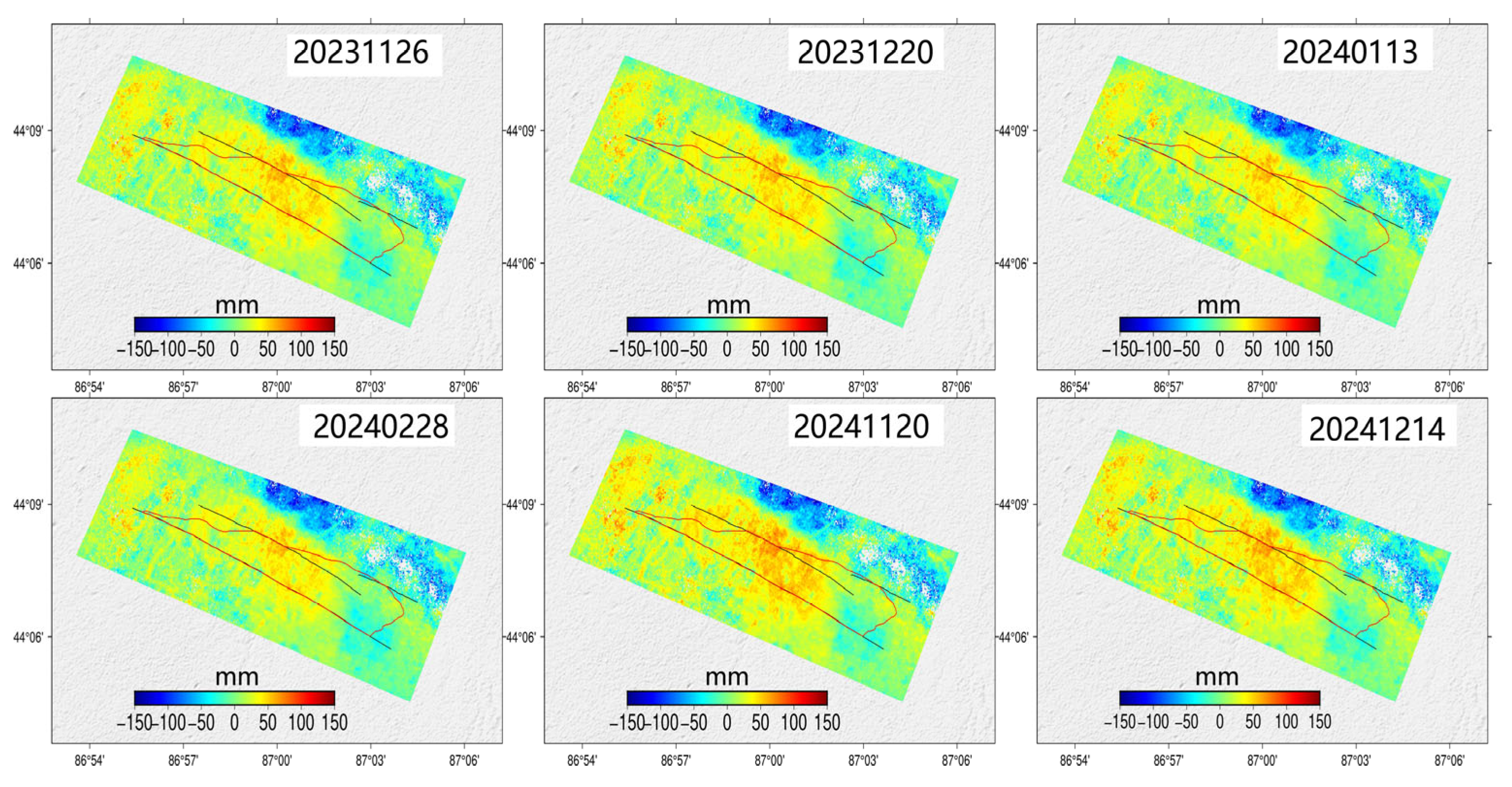


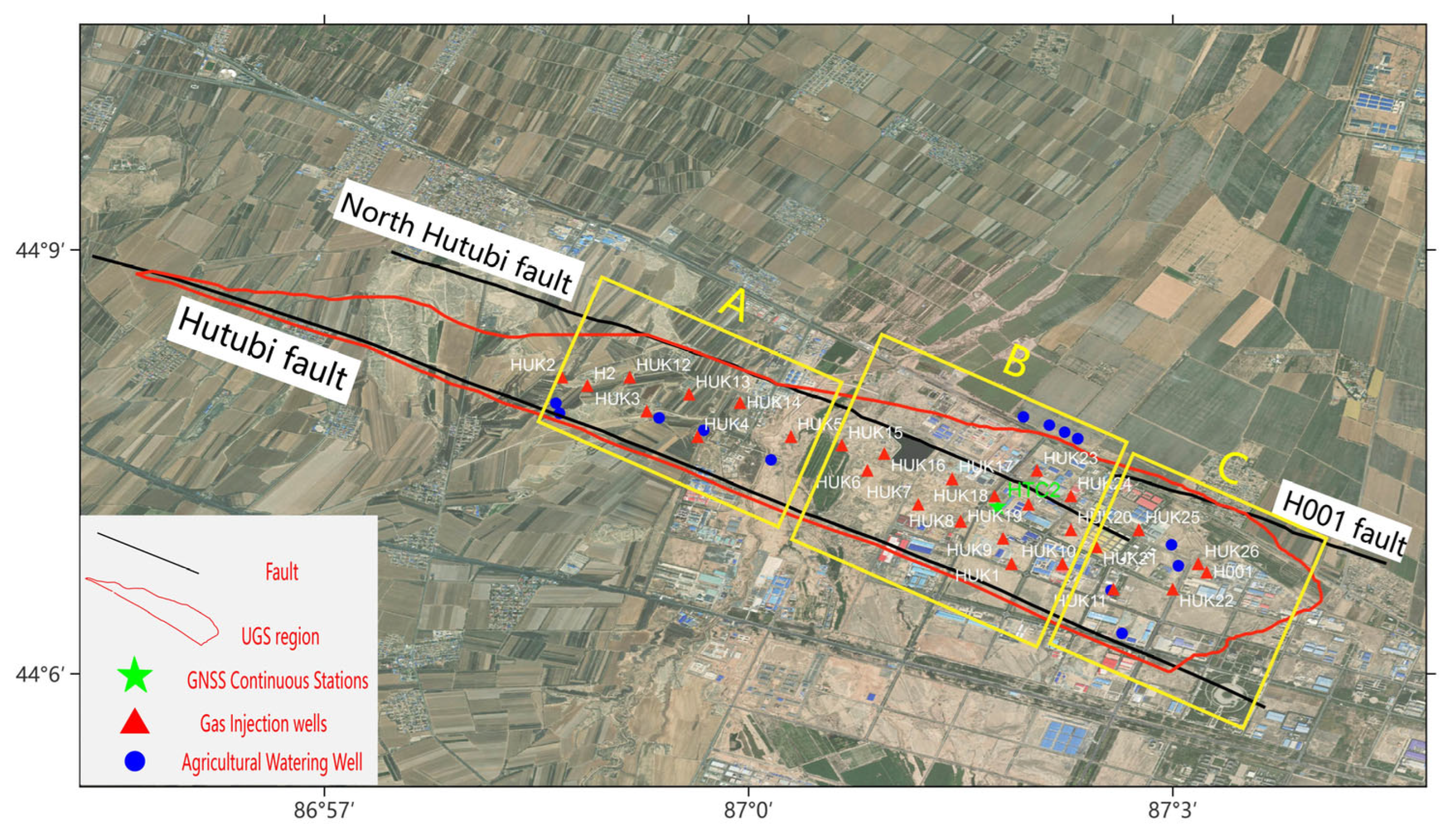

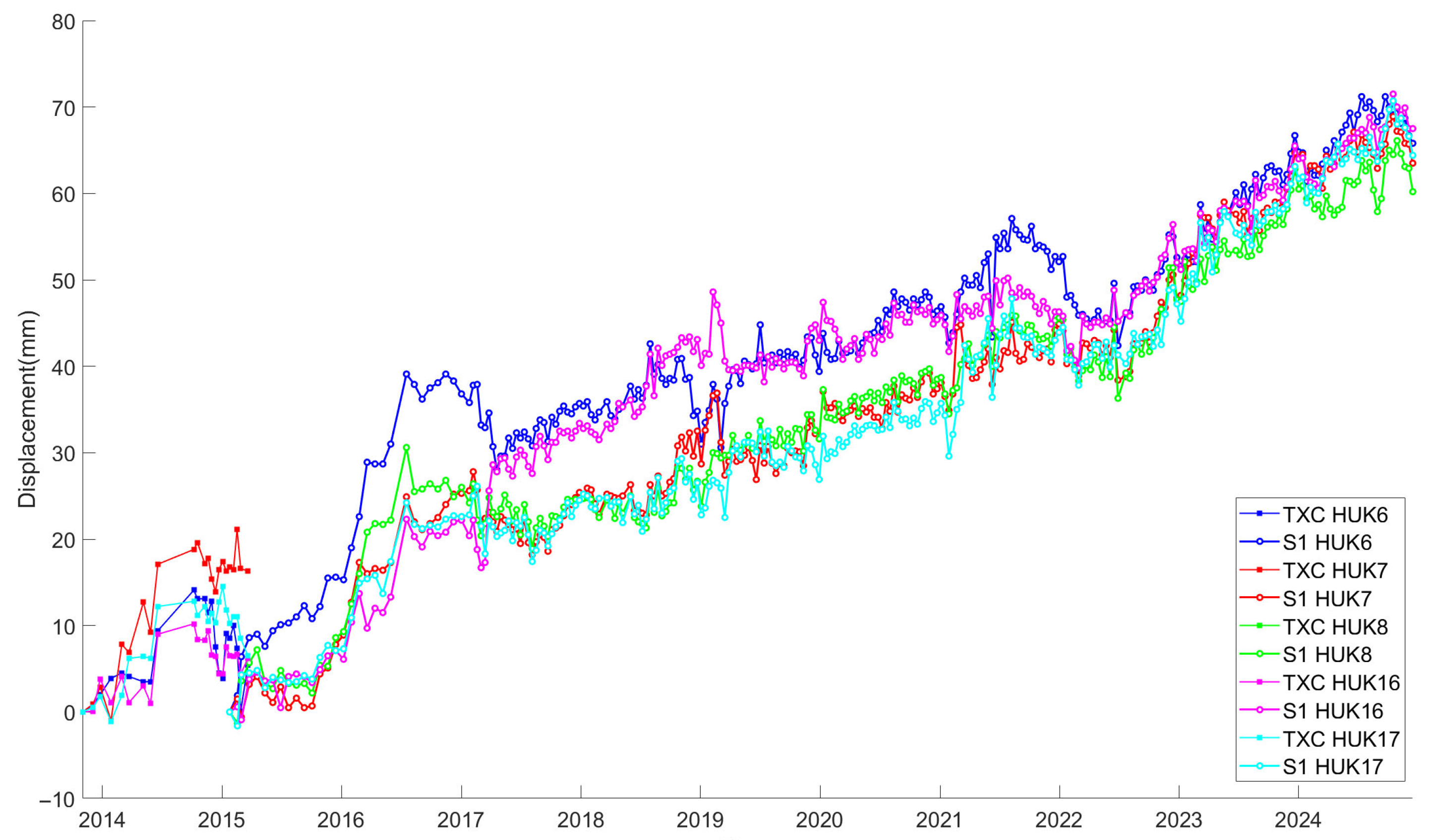
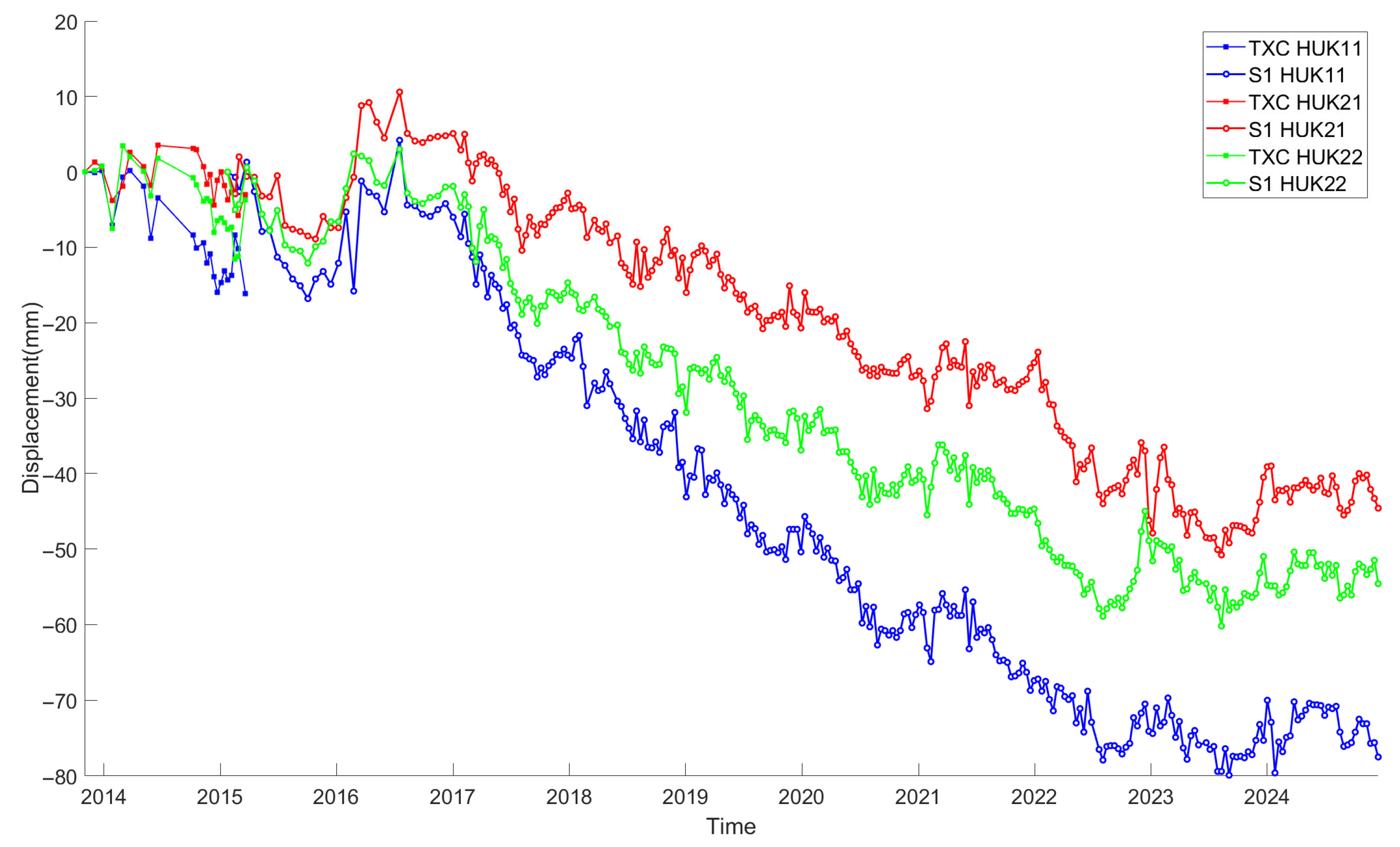
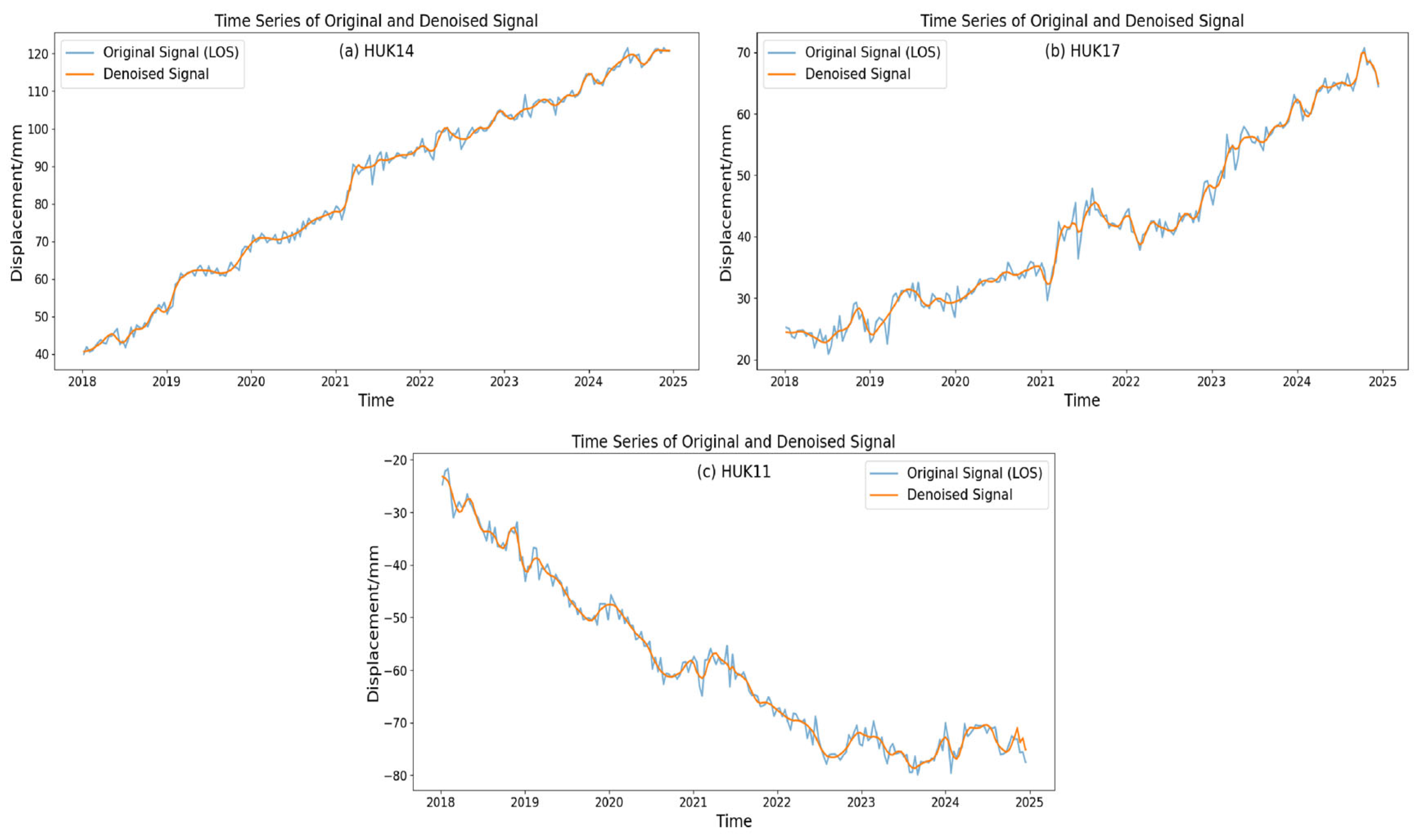
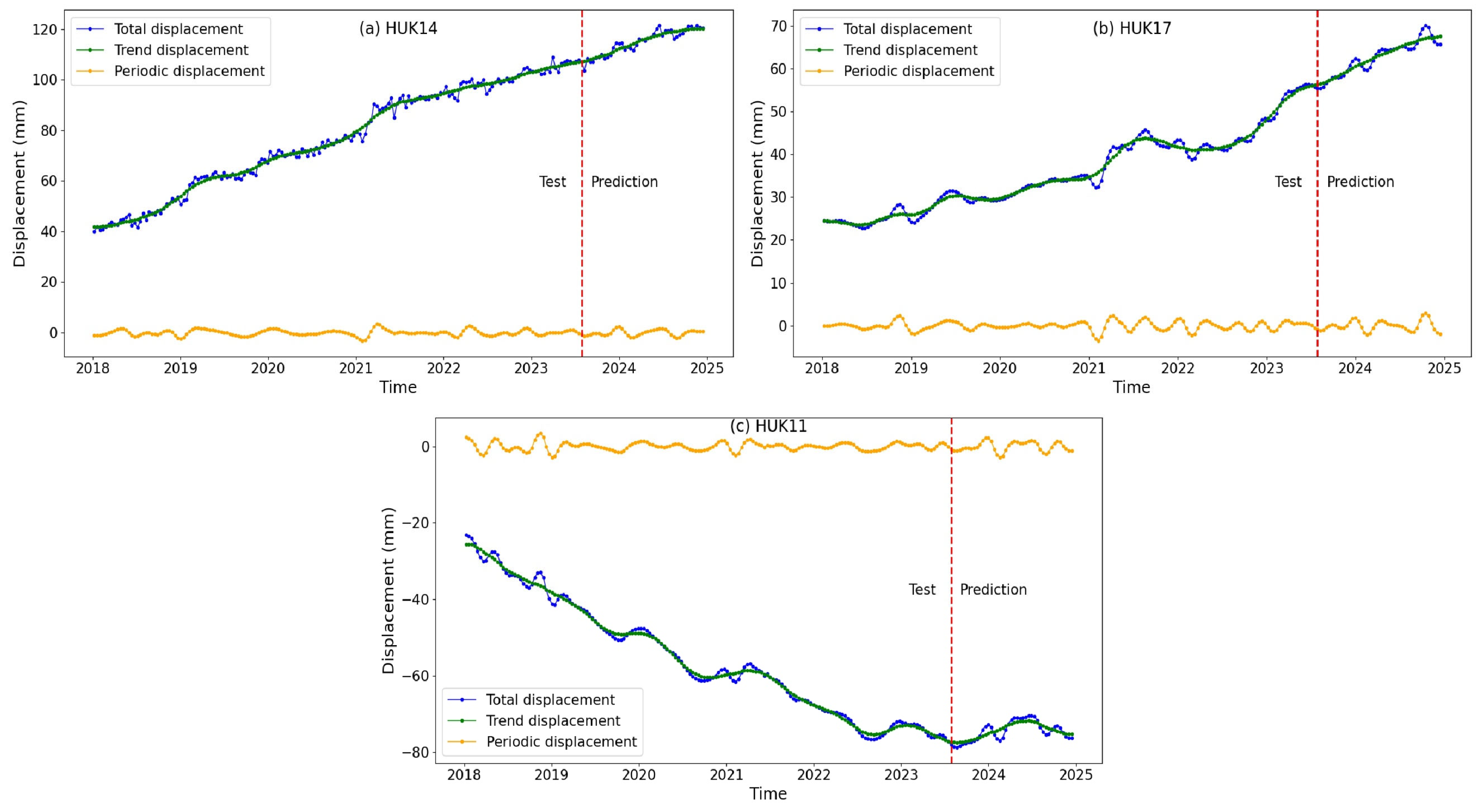

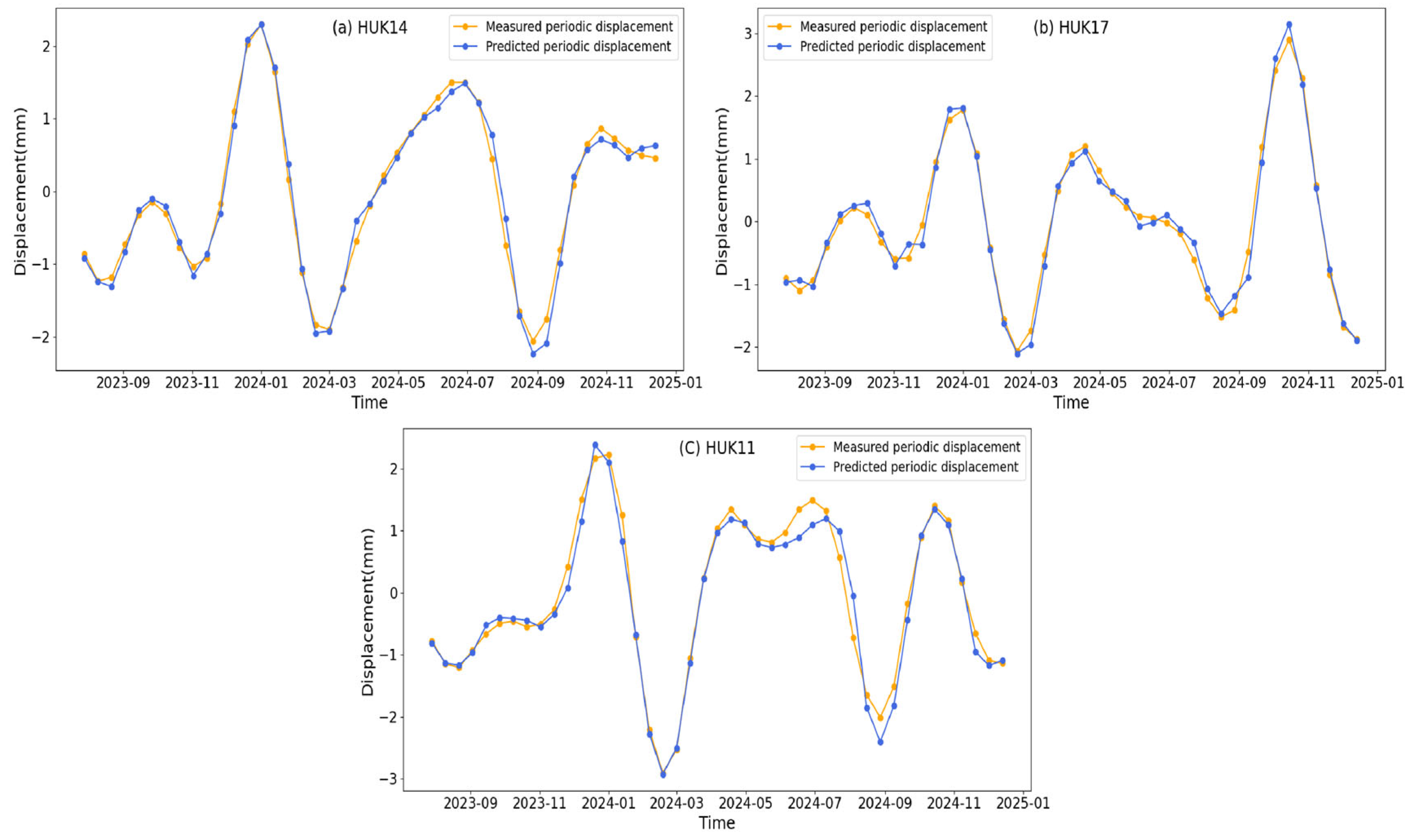

| Sensor | TerraSAR | Sentienl-1 |
|---|---|---|
| Orbit | Ascending | Ascending |
| Repeat cycle (d) | 11 | 12 |
| Incidence angle (degrees) | 30.97 | 33.83 |
| Image resolution (m) | 3 × 3 | 5 × 20 |
| Wavelength (cm) | 3.2 | 5.5 |
| Number of images | 23 | 267 |
| Acquisition dates | 11 November 2013–21 March 2015 | 24 January 2015–24 December 2024 |
| Gas Well | R2 | RMSE | MAE |
|---|---|---|---|
| HUK14 | 0.9935 | 0.3519 | 0.2970 |
| HUK17 | 0.9975 | 0.1765 | 0.1503 |
| HUK11 | 0.9818 | 0.2521 | 0.2101 |
| Gas Well | R2 | RMSE | MAE |
|---|---|---|---|
| HUK14 | 0.9842 | 0.1409 | 0.1091 |
| HUK17 | 0.9829 | 0.1548 | 0.1285 |
| HUK11 | 0.9695 | 0.2222 | 0.1594 |
| Gas Well | Model | R2 | RMSE | MAE |
|---|---|---|---|---|
| HUK14 | GWO-VMD-GRU | 0.9941 | 0.3675 | 0.3052 |
| GRU | 0.9885 | 0.5077 | 0.4147 | |
| LSTM | 0.9835 | 0.6076 | 0.4946 | |
| HUK17 | GWO-VMD-GRU | 0.9969 | 0.2173 | 0.1748 |
| GRU | 0.9853 | 0.4767 | 0.3645 | |
| LSTM | 0.9770 | 0.5954 | 0.4970 | |
| HUK11 | GWO-VMD-GRU | 0.9819 | 0.3423 | 0.2686 |
| GRU | 0.9607 | 0.5062 | 0.3933 | |
| LSTM | 0.9503 | 0.5712 | 0.4514 |
Disclaimer/Publisher’s Note: The statements, opinions and data contained in all publications are solely those of the individual author(s) and contributor(s) and not of MDPI and/or the editor(s). MDPI and/or the editor(s) disclaim responsibility for any injury to people or property resulting from any ideas, methods, instructions or products referred to in the content. |
© 2025 by the authors. Licensee MDPI, Basel, Switzerland. This article is an open access article distributed under the terms and conditions of the Creative Commons Attribution (CC BY) license (https://creativecommons.org/licenses/by/4.0/).
Share and Cite
Huang, W.; Liao, W.; Li, J.; Qiao, X.; Yusan, S.; Yasen, A.; Li, X.; Zhang, S. The Long-Term Surface Deformation Monitoring and Prediction of Hutubi Gas Storage Reservoir in Xinjiang Based on InSAR and the GWO-VMD-GRU Model. Remote Sens. 2025, 17, 2480. https://doi.org/10.3390/rs17142480
Huang W, Liao W, Li J, Qiao X, Yusan S, Yasen A, Li X, Zhang S. The Long-Term Surface Deformation Monitoring and Prediction of Hutubi Gas Storage Reservoir in Xinjiang Based on InSAR and the GWO-VMD-GRU Model. Remote Sensing. 2025; 17(14):2480. https://doi.org/10.3390/rs17142480
Chicago/Turabian StyleHuang, Wang, Wei Liao, Jie Li, Xuejun Qiao, Sulitan Yusan, Abudutayier Yasen, Xinlu Li, and Shijie Zhang. 2025. "The Long-Term Surface Deformation Monitoring and Prediction of Hutubi Gas Storage Reservoir in Xinjiang Based on InSAR and the GWO-VMD-GRU Model" Remote Sensing 17, no. 14: 2480. https://doi.org/10.3390/rs17142480
APA StyleHuang, W., Liao, W., Li, J., Qiao, X., Yusan, S., Yasen, A., Li, X., & Zhang, S. (2025). The Long-Term Surface Deformation Monitoring and Prediction of Hutubi Gas Storage Reservoir in Xinjiang Based on InSAR and the GWO-VMD-GRU Model. Remote Sensing, 17(14), 2480. https://doi.org/10.3390/rs17142480





